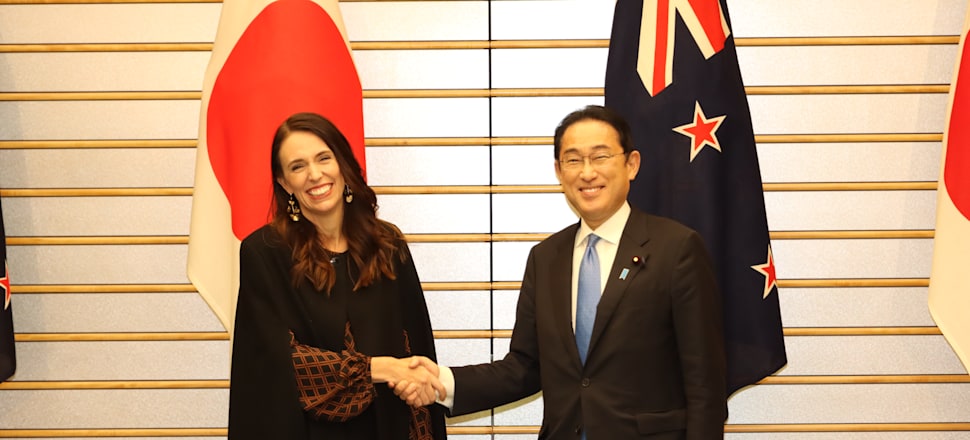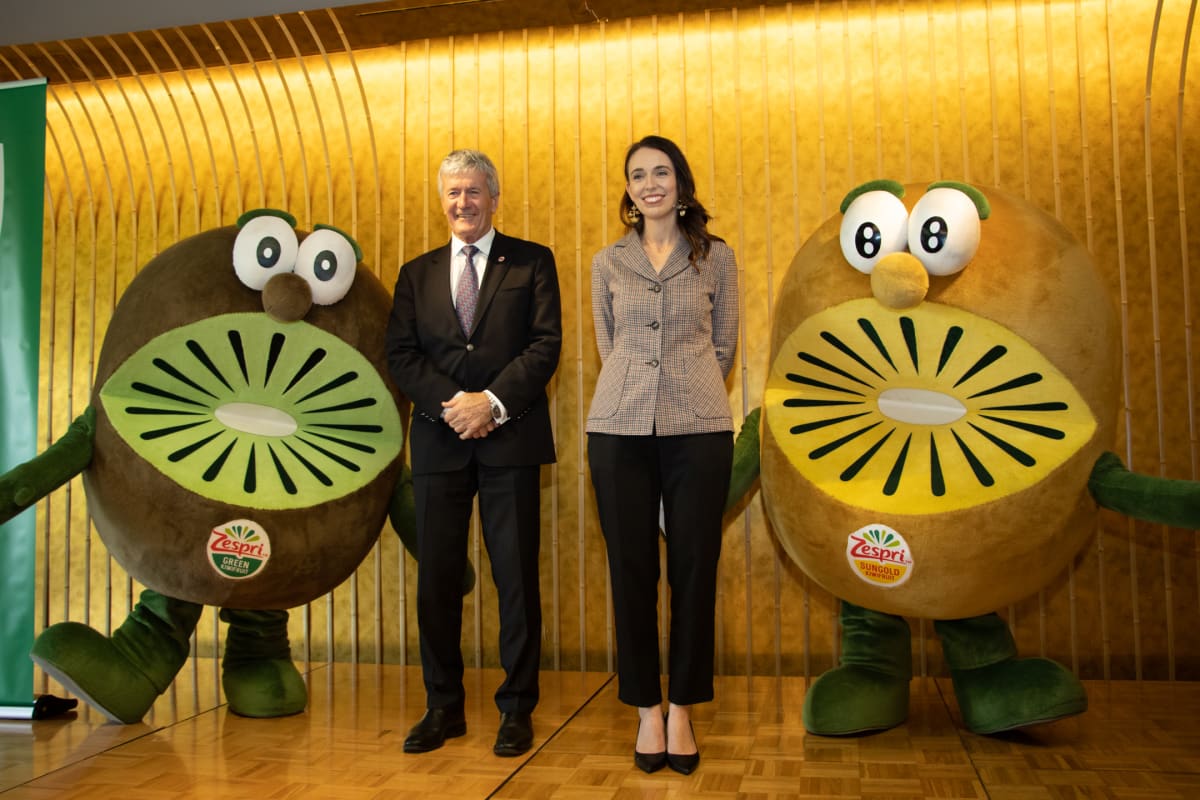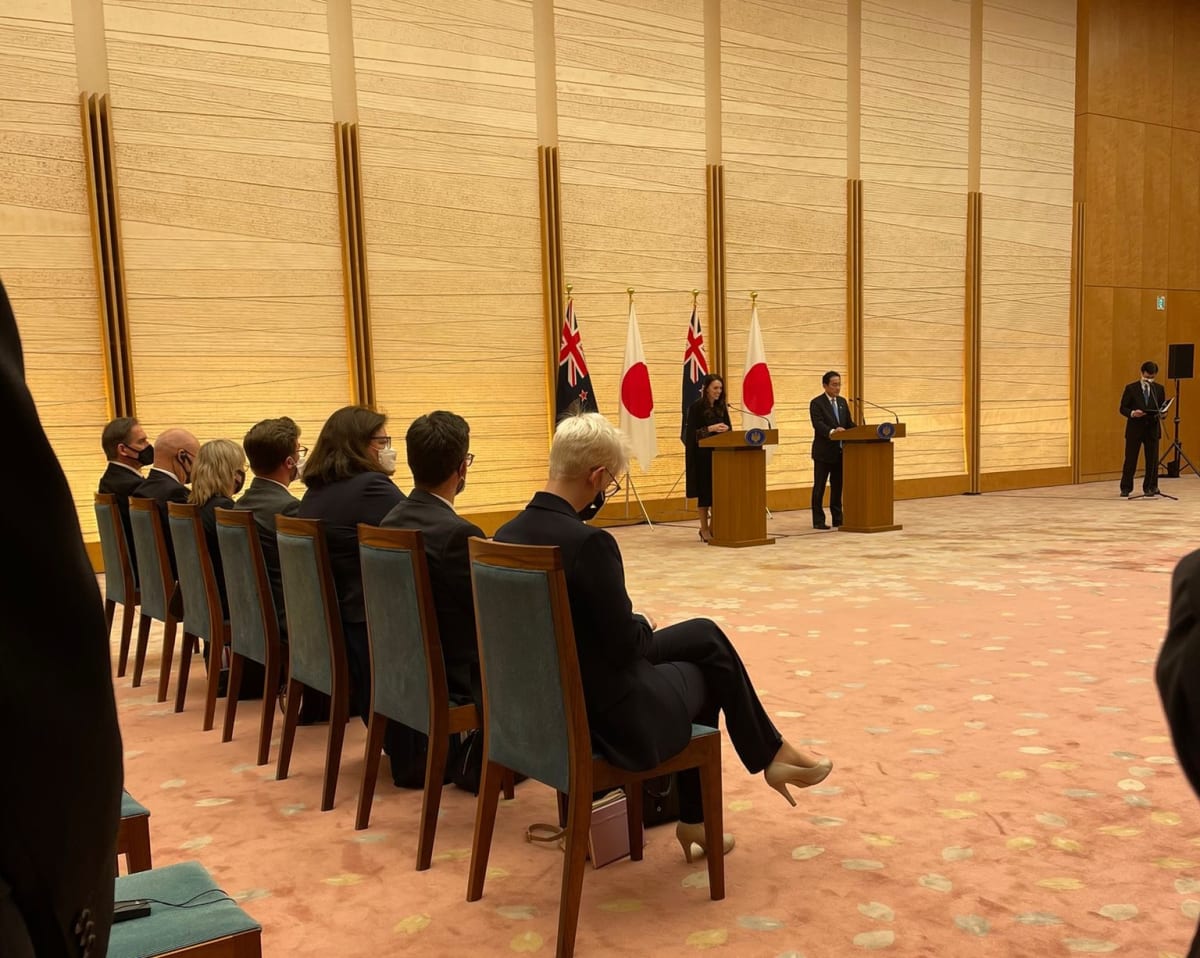
From “quirky’’ dancing Kiwifruit to powerful diplomacy talks - the Prime Minister’s first day in Tokyo had it all, writes political editor Jo Moir.
Jacinda Ardern’s touchdown in Tokyo was a masterclass welcome for a visiting leader.
It kick-started with two fluffy and cheeky kiwifruit mascots – already Japanese sensations – and ended with frank but united high-level talks with an influential leader on the world stage.
Ardern would have headed to bed at the Imperial Hotel on Thursday night satisfied with a good day at the international office.
Making a promotional stop with Zespri in Tokyo was a golden opportunity for the Prime Minister, especially when the export market is worth $750 million to New Zealand and only continues to grow.
The furry fruit swayed and danced to the sound of a live (albeit mournful) musical performance, and playfully plodded around the room while the speeches, calligraphy competition and pavlova decorating was done.
It was a perfect blend of Japanese and Kiwi full-of-laughter-and-warm welcome, setting the tone for the rest of the day.
The small mercy Ardern was grateful for at the Zespri event was not having to yet again be photographed holding the hands of the Kiwifruit Brothers.
That happened in 2019 when last visiting and she told Newsroom the reunion was a “flashback’’.
“I won’t give a twist on whether that was a positive flashback or not - at least there was no handholding, small mercies.’’

Videos and photos of the interactions provided light relief for social media users back home where timelines were at the same time filling up with the news inflation had just hit a record 6.9 percent.
One reporter’s video of the mascots had more than one million views by the end of the day.
From there Ardern headed to the iconic Tokyo Tower to announce alongside Toyota bosses the hydrogen-fuelled car partnership about to hit the streets of Auckland.
The Government is pitching in $20 million from the Covid Recovery Fund to set up refuelling stations for the small fleet to be used in the upper and central North Island.
Trade Minister Damien O’Connor went for a spin in one of the vehicles in the bustling central city streets.
The self-proclaimed “petrol head’’ didn’t exactly hit frightening speeds but was convinced on his return it was the way of the future.

But from there it was on to the whole point of this overseas excursion – facetime with Prime Minister Fumio Kishida at his residence, where he hosted a summit and joint press conference.
Ardern has a well-established knack for instantly finding common ground and creating a sense of rapport with those she meets.
It didn’t matter that it was the first time they’d seen or spoken to each other – from the moment they entered the summit room together a natural bond was clear.
She went in for a handshake, he went in for a fist bump.
They laughed and both switched, thus doing the opposite again, and finally settled on a handshake while Ardern joked perhaps a “high-five’’ would have been better.
Even the Japanese journalists were excited to see the pair together, one commenting to the Kiwi contingent that he had been looking forward to seeing her in real life given how “well-liked she is’’.
That same journalist spent the 15 minutes before the arrival of the leaders quizzing the press gallery pack on what the Prime Minister’s plane was like, whether we were allowed to drink on it, and if we’d visited Hobbiton.
He also shared his love of the New Zealand anthem, saying it was incredibly “uplifting’’ compared to his own nation’s.
“Ours is the sort of anthem that when you hear it before a sports game you’d think you’d already lost,’’ he declared.
There is no tolerance or acceptance in Japanese journalism for having more than one job at a time.
If you’re a reporter then you’re only allowed to take notes, if you’re a television cameraman you can only take video and if you’re a photographer you can only take stills.
It comes from the press industry being a powerful lobby group in Japan and therefore having rules to protect the industry and the various jobs within it.
Despite its power, the industry hasn’t managed to secure itself actual seats at a press conference and when a writer's sole job is writing, or in most cases typing, doing so while standing up is not exactly easy.
One of the New Zealand press pack members sat, in error, in seats reserved for officials. A quick “you’re not allowed to sit there’’ from a friendly ally saw everyone promptly moved on.

The white-gloved Japanese staffer who had neatly and carefully placed all the translation earpieces on individual seats was forced to redo it again.
Japan is the third-biggest economy in the world and Kishida and Ardern couldn’t have been more in step with each other as they sent their warning shots from Tokyo on Thursday night.
With everyone in their rightful place Kishida and Ardern made their entrance where they announced their governments would negotiate an intelligence-sharing agreement to strengthen ties between the two countries.
It comes at a time when China is exercising assertiveness in the Indo-Pacific region and neighbouring leaders are on high alert about what that might mean in a world where rules-based order is increasingly under threat.
Kishida had noted at the start of the summit meeting he hoped to have a “frank exchange of views’’ about the two countries’ strategic cooperation and work towards a free and open Pacific.
“Russia’s aggression against Ukraine has shaken the very foundation of the international order, and I want to work closely with New Zealand to take resolute responses,’’ he said.
Throughout Ardern’s trip, first to Singapore and then onto Japan, the rising influence and power of China in the Pacific has been front of mind.
While in Singapore, news broke that China and the Solomon Islands had signed a security pact that could see Chinese militarisation in the Pacific.
Following the summit meeting Kishida spoke of the world being at a “crucial moment’’ and while his joint statement with Ardern didn’t specifically mention China it referred to the “need to address growing strategic challenges in the Pacific that could destabilise the regional security environment’’.
The united front and direct rhetoric won’t go unnoticed by China, and New Zealand needs all the allies and trading partners it can get given the heavy reliance on China’s market.
Japan is the third-biggest economy in the world and Kishida and Ardern couldn’t have been more in step with each other as they sent their warning shots from Tokyo on Thursday night.







